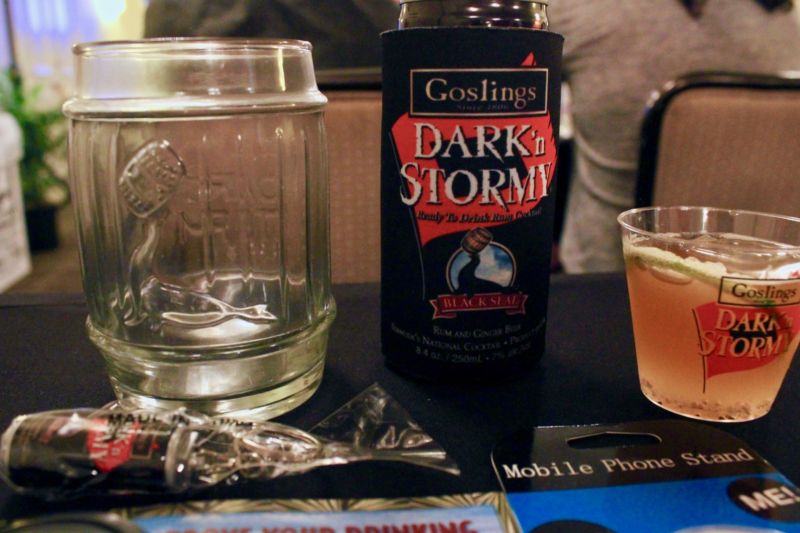
NEW ORLEANS—Anyone who fancies themselves a fan of cocktails knows the names: the Manhattan, Old Fashioned, Martini, Margarita, on and on and on. In the drinks world, such recipes have stood the test of time and grown into industry icons over decades. But unlike similar cultural colossuses elsewhere—from Mickey Mouse on screen or "Hey Jude" in the stereo—you can find the Negroni being deployed freely at virtually every bar in America. What gives?
"Can you copyright and own a recipe? A recipe in the eyes of the law doesn't have that creative spark," says attorney Andrea Mealey, an intellectual property expert who has done legal work for beverage companies like Gosling's Rum. During a panel on IP in the bar industry at the 2019 Tales of the Cocktail (TOTC) conference, she next points at the ceiling in this conference room. "The design of that chandelier—someone had to come up with it. It's creative, and you can own copyright on that design. I can do a slightly different design and own that as well. But a recipe is like a phone book in the eyes of the law—you can't own something so factual."
In the modern drinks world, Mealey not-so-subtly implies copyright may be the most useless legal tool for enterprising bartenders. (You could at least patent some amazing new tool, in theory.) It's a not-so-dirty secret that many have increasingly become aware of in this modern cocktail renaissance, where a killer recipe at an influential bar can suddenly show up on menus worldwide with little more than a written credit. The US Copyright Office puts it plainly: "A mere listing of ingredients or contents, or a simple set of directions, is uncopyrightable."
"In no other creative business can you so easily identify money attached to your creative property," bartender Eben Freeman told The Atlantic back at the 2010 TOTC conference. Freeman has been credited as a pioneer of fat-washing, the practice of infusing a spirit with a fat-heavy flavor like bacon, but Bacon Old Fashioneds appear all over without a cent going back to Freeman. "There is an implied commerce to our intellectual property. Yet we have less protection than anyone else."
Luckily, Mealey's panel this week emphasized there is some hope for modern bartenders looking to profit off good imbibing ideas. And while it takes a lot of circumstance and effort to protect the IP of an individual drink, bartenders can think bigger and package a lot of industry know-how together into entities more easily licensed out to others.
Trademarks and tiki
When it comes to drinks, legal muscle has historically stemmed from two entities: trademarks and trade secrets. Brands like TGI Fridays used to trademark drinks to prevent chain competitors from offering the same things, and individual drinks like the Dark 'n' Stormy or the Painkiller (err, Dark 'n' Stormy® and Painkiller®) are trademarked by individual liquor brands. The Bermudan brand Gosling's earned a US trademark on the Dark 'n' Stormy in 1991, and ever since the official recipe has dictated Gosling's brand rum and Gosling's brand ginger beer. (It doesn't specify measurements, notably—"A really weak Dark 'n' Stormy is still a Dark 'n' Stormy," Mealey says.)
The basic logistics for a trademark, however, make this a rare route for success. To start, Gosling's trademark was helped by its use of specifics (Gosling's Rum, Gosling's Ginger Beer) and later strengthened by the brand's ultimate move into offering those as a package: a pre-canned Dark 'n' Stormy.
"It makes sense to people in Washington DC—'This is a drink, we can trademark a drink, Class 32 Beverages, a-ha!,'" Mealey says. "It's a specific kind of rum with a specific ginger beer—this is a Dark 'n' Stormy."
And while applying for a trademark is relatively easy and inexpensive (comparatively for most legal processes), Mealey says the key to maintaining it is showing a willingness to defend that trademark. Gosling's has done just that throughout the years. The rum makers famously took legal action against the second-biggest alcohol company in the world, Pernod Ricard, back in 2015. Pernod had posted a recipe for a Dark 'n' Stormy to its website, but it used Malibu Rum rather than Gosling's. Eventually, Pernod opted to settle and entered into an agreement with Gosling's preventing a future Dark 'n' Stormy storm.
Not every trademark defense ends with legal action, of course. Mealey says she likely gets three notices a week about restaurants or in-flight menus, and often these just spark cease and desist letters. (Gosling's in the past had sent C&D letters even to bloggers.) The trick now, at least from the company's perspective, is striking the right balance between muscle and market opportunities. If a bar pushes Dark 'n' Stormy drinks with the wrong rum, for instance, can a letter encourage them instead to use Gosling's? A new consistent customer represents a better outcome than a legal fight. (Panelist Daniel Eun, an attorney/bartender formerly of PDT, knows that first hand—he helped open a bar called Painkiller in NYC, which quickly heard from Pusser's Rum. Eun's bar eventually became PKNY and certainly opted to carry different rums.)
"If you invest in the brand, you have to enforce it. Otherwise, you'd have it genericize—Band-Aid and Escalator are trademarks," Mealey says (and one of those has descended to the ground floor of generic). "We don't ever want a rum and ginger to be a Dark 'n' Stormy, so we have to keep these third parties at bay in a way that doesn't make you a bully out in the market. Just call it a rum and ginger; it's not a Dark 'n' Stormy unless you're putting our rum in it, which would be fabulous."
reader comments
132